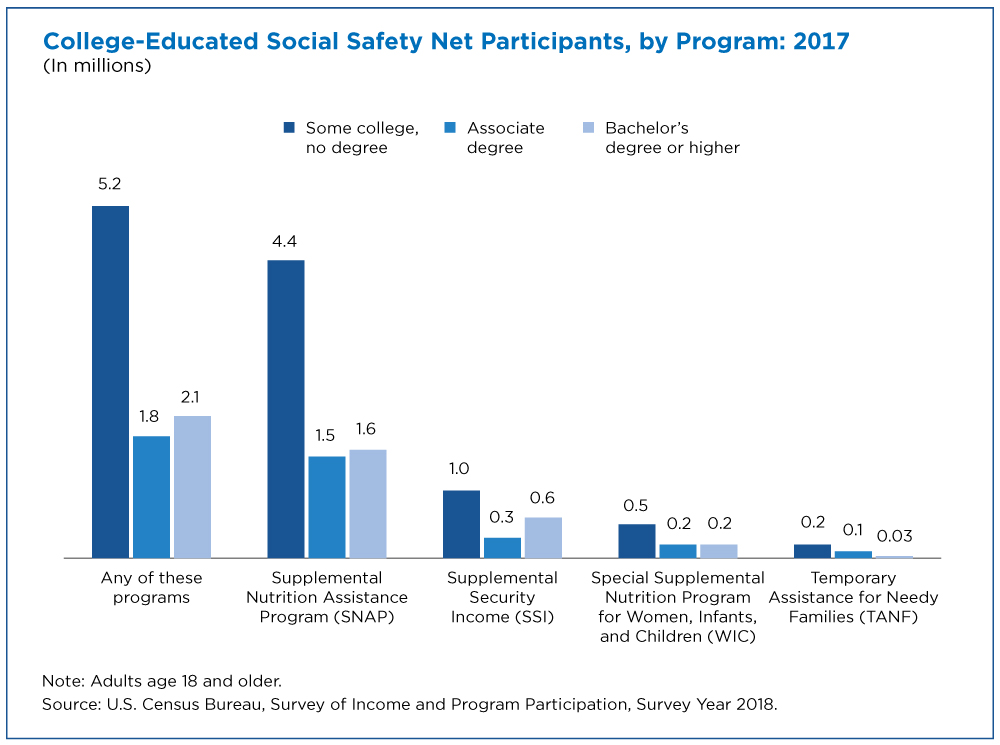Those With a High School Diploma or Less Make Up Majority of Government Assistance Recipients
Adults without any post-secondary education made up the majority of participants in four key social safety net programs but college-educated adults account for over a third of some programs’ recipients.
These findings come from tables recently released by the U.S. Census Bureau, which provide detailed information on program participation and income transfers in 2017 from the Survey of Income and Program Participation (SIPP).
More than one in three adults receiving SNAP had attended at least some college classes and about one in seven had earned a college degree.
Education profiles of four key government assistance programs — the Supplemental Nutrition Assistance Program (SNAP), Supplemental Security Income (SSI), the Special Supplemental Nutrition Program for Women, Infants, and Children (WIC), and Temporary Assistance for Needy Families (TANF) — reveal the broad socioeconomic range of adults who rely on government assistance.
Education and Program Receipt
Adults with the lowest levels of educational attainment were the most likely to participate in assistance programs in 2017 but the education profiles of recipients varied across programs.
Those with a high school diploma or less accounted for over half of WIC participants and about three-quarters of SSI recipients.
Those with college degrees (either an associate or a bachelor’s degree) accounted for as many as one in five of some programs’ participants. They made up 19.4% of WIC recipients, for example.
More than one in three adults receiving SNAP had attended at least some college classes and about one in seven had earned a college degree. SNAP provides food assistance to families below certain income thresholds and is the largest assistance program examined here.
Social Safety Net Participation Among College Educated
About nine million college-educated adults participated in at least one of the four government programs listed above.
This number includes those who attended college but never earned a degree, those who earned an associate degree (a two-year degree often earned at a community college) and those who earned a bachelor’s (or higher) degree.
Most of those who attended but had not graduated from college were not enrolled in any education program within the year, suggesting they were not actively pursuing a degree. This is consistent with many programs limiting access to benefits for many college students.
Among the college-educated recipients examined here, about four million had at least an associate degree and about two million had a bachelor’s (or higher) degree.
Roughly three million college graduates, including 1.6 million bachelor’s degree holders, received SNAP benefits.
Who Are the College-Educated SNAP Recipients?
Drawing on additional SIPP data, we can compare all adults with a bachelor’s degree to those with the same degree who were also receiving SNAP in 2017.
The data show, for example, that while 52.9% of all bachelor’s degree holders were women, 63.6% of SNAP recipients with a bachelor’s degree were women.
Similarly, Black people made up 8.9% of all adults with a bachelor’s degree. But Black people were a quarter (25.3%) of those with a bachelor’s degree who were also getting SNAP.
The same pattern holds for Hispanic adults. They made up about 8.7% of all adults with a bachelor’s degree but 18.1% of those with a bachelor’s degree who received SNAP were Hispanic people.
There were also clear differences by marital status and the presence of children in the household.
Bachelor’s degree holders receiving SNAP were less likely than all bachelor’s degree holders to be married (38.4% compared to 63.9%), more likely to be divorced or separated (27.0% compared to 10.1%), and more likely to have children under 18 in the household (39.0% compared to 30.9%).
The estimates presented here are subject to sampling and nonsampling error. To learn more about the statistical guidelines used in producing these estimates, please visit the SIPP 2018 source and accuracy document.
Michael D. King is a survey statistician in the Census Bureau’s Program Participation and Income Transfers Branch.
Subscribe
Our email newsletter is sent out on the day we publish a story. Get an alert directly in your inbox to read, share and blog about our newest stories.
Contact our Public Information Office for media inquiries or interviews.
-
America Counts StoryMost Families With 2018 SNAP Benefits Had At Least One Person WorkingJuly 21, 2020Most families who received Supplemental Nutrition Assistance Program benefits had at least one worker and about a third included two or more workers.
-
America Counts StoryDemographic SNAPshot: Not All Eligible for Food Assistance Gets AidFebruary 02, 2021A new data visualization shows the demographic characteristics of people eligible for the Supplemental Nutrition Assistance Program and those who receive it.
-
America Counts StoryDespite Unemployment Insurance, Many Households Struggle With BasicsMarch 09, 2021The Household Pulse Survey shows that 31.2% of households that used unemployment insurance reported a very difficult time paying for usual household expenses.
-
EmploymentThe Stories Behind Census Numbers in 2025December 22, 2025A year-end review of America Counts stories on everything from families and housing to business and income.
-
Families and Living ArrangementsMore First-Time Moms Live With an Unmarried PartnerDecember 16, 2025About a quarter of all first-time mothers were cohabiting at the time of childbirth in the early 2020s. College-educated moms were more likely to be married.
-
Business and EconomyState Governments Parlay Sports Betting Into Tax WindfallDecember 10, 2025Total state-level sports betting tax revenues has increased 382% since the third quarter of 2021, when data collection began.
-
EmploymentU.S. Workforce is Aging, Especially in Some FirmsDecember 02, 2025Firms in sectors like utilities and manufacturing and states like Maine are more likely to have a high share of workers over age 55.







